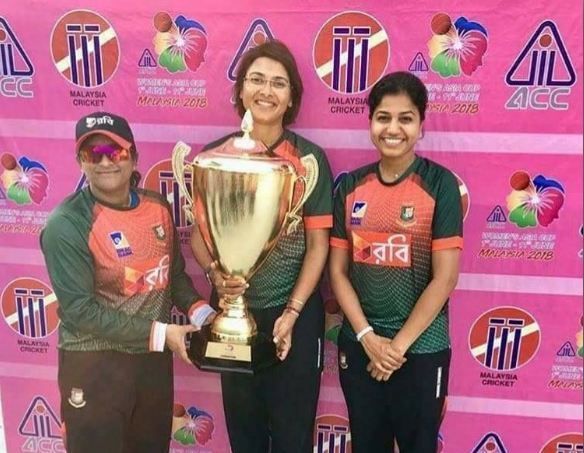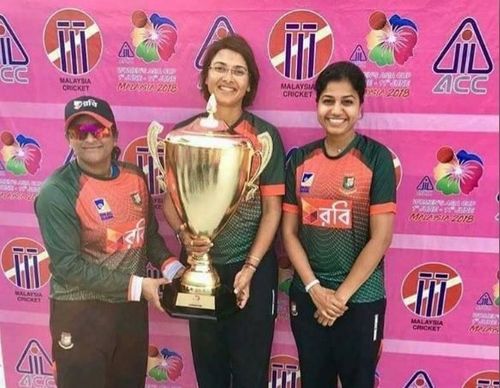
"The year 2017 was an actual turning point for Indian Women’s cricket," says Devieka Palshikaar

The Women’s T20 Asia cup title was clenched by a fiery Bangladesh Women’s Cricket Team but few would know that behind their meteoric success, stand tall three Indians - Coach Anju Jain, Assistant Coach - Devieka Palshikaar and team physio - Anuja Dalvi-Pandit.
Cricket is not new to Devieka. With over two decades of experience and having played for the Indian team, she has been a great leader and an equally successful coach to Assam, Goa, Mumbai, India, and the Bangladesh cricket teams.
In an exclusive interview, Devieka speaks about the struggles of players, in general, and how Women's Cricket has evolved over the last few years.
Here are some excerpts of the interview:
Mostly cricket is perceived as a male-dominated game in India. How did you develop an interest in this sport and did you ever dream of playing for India?
There was no plan as such. I was just a simple gully cricketer, but an expert one. I had the interest and enjoyed the game, but back then in the 90s, I hardly knew women played cricket professionally.
One fine day, when I was pursuing CA, I saw a girl with a cricket kit bag and the thought struck me to restart cricket. That’s where it all started.
You’ve been a part of women’s cricket for almost two decades, what kinds of struggles you faced during your playing days?
While I was playing domestic and international cricket, we were not provided with many facilities. I remember, during one of our tournaments, we were not given proper rooms to stay and were asked to sleep in a badminton hall.
For many years we were looking after our own expenditures and were not getting paid, but we never allowed that to dilute our love and passion for cricket.
Every time when my teammates and I traveled with our kit bags, people used to ask if we were hockey players as girls playing cricket in those days wasn’t even known by the majority of people in India.
How have those struggles changed in today’s time?
I think it has a lot to do with the culture predominant here. Like for instance, women, post-education, are expected to get married and start a family. A few brave ones challenge the status quo and continue to pursue their dreams.
Having said that, a woman cricketer requires more time to get recognized in this male dominant game. She needs to really work fingers to the bone to create and maintain her identity and to shine in all formats of the game. But over the years, there is marked progress. People at least know that women play cricket!
Can you walk me through the turning point that served as a game changer to improvise the perception of women cricket?
The year 2017 was an actual turning point for Indian women’s cricket.
In 2005, the Indian Women’s World Cup squad bagged the title of runners-up but they didn’t get enough acknowledgment for their hard work.
Whereas the 2017 team also made it to the finals of World Cup and secured the second position, our run to the 2017 final definitely changed the perspective of people towards women’s cricket.
In addition to that, social media too served as a huge platform for information proliferation and gave the due recognition to the Indian women’s squad of 2017.
All this has served Women’s cricket well, and the players are now provided with good facilities and remuneration. It is really good to see other nations taking the initiative to participate in women’s cricket.
What are your views on women’s IPL?
India has a huge population, so there is always an extra scope for experimentation. There is no dearth of talented young adults in our country. So it is a really great decision taken by BCCI. This will provide a good platform to the young women cricketers to showcase their talents.
Like in the last season of women’s IPL, only two teams played against each other whereas this year there were three sides competing. I genuinely hope that next year the number of teams increases.
This is a really good initiative that gives a different kind of exposure to the young budding women cricketers and I hope it will improve the standards of domestic cricket from the grass root level.
What are your views on the pay gap between men and women cricketers?
There is certainly a huge rift here. I remember when I was playing international cricket in the early 2000’s we got 1000 Rupees as match fee. So after playing a series we used to return home with five or six thousand rupees.
Although in today’s time, the payment of women cricketers is better, comparatively. So the things have changed for the betterment of the women’s cricket we can say but at the same time, I feel there's a long way to go till we see equal pay to men and women in cricket here in India.
How has Cricket changed your life?
In fact, cricket has changed me a lot. Throughout my schooling and junior college years, I’ve always been very studious, but was lazy at the same time. It wasn’t until I decided to play cricket that I started waking up at around 5 am. Cricket is the only thing that goes on in my mind throughout… 24x7. Also, I was a big foodie initially but ever since I’ve started playing cricket I follow a strict diet. Cricket is the only thing that keeps me going, it keeps me on my toes and I’m a go-getter now.
I don’t know what I would have been if I were to be a CA, maybe I’d be complacent and a ‘waking up at 10 am’ kind of person. Even if I am given a chance to change my life, I’ll never want to change anything. I am who I am because of cricket and it’s nothing but pure passion for me.
What major learning from the game that you’d like to pass on to the next generation women cricketers?
Punctuality, discipline and there are no short cuts for success - just as in any area of life. Cricket is a very unpredictable game, so the only thing in your hand is to be consistent in giving your best and soon the results will follow.